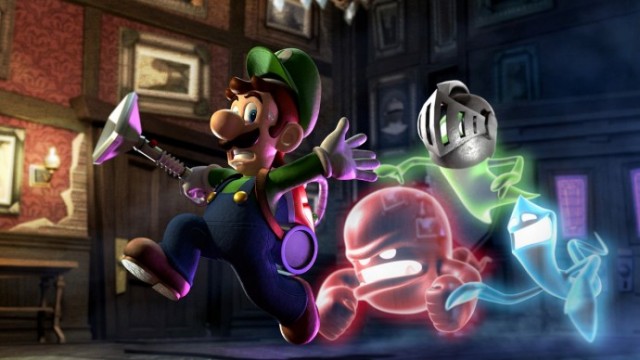
Believe it or not, Luigi’s Mansion: Dark Moon is already over five years old. I was surprised by how much time has passed since this sequel to GameCube’s Luigi’s Mansion dropped. As far as follow-ups go, Dark Moon is fascinating in that Nintendo didn’t develop the title internally. Instead, the Japanese giant turned to western studio Next Level Games to helm the creation of the game. Next Level Games had built up some goodwill amongst the Nintendo faithful with its work on Punch-Out!! for Wii, but there was nonetheless some trepidation from fans who worried that the developer wouldn’t be able to hold a candle to Nintendo’s own efforts on the original Luigi’s Mansion. Those fears were largely unfounded, thankfully. The game was a roaring success when it launched, garnering rave reviews from critics and fans alike. With the remake of Luigi’s Mansion coming soon and having just replayed the original, the time felt right to return to Dark Moon and give it another look!
The setup in Dark Moon is drastically different from Luigi’s Mansion. Gone is the singular mansion and its chapter breaks, replaced with multiple mansions and stages to get through. Having more than one mansion was definitely a positive here, as it allows for more varied environments to explore. The stage structure, however, works against this a bit. In Luigi’s Mansion, part of that game’s success was in being able to lackadaisically meander through the mansion’s many halls and rooms. Overall, there wasn’t a great sense of urgency to rush through and complete each objective. The emphasis was instead on enjoying the journey and investigating every nook and cranny.
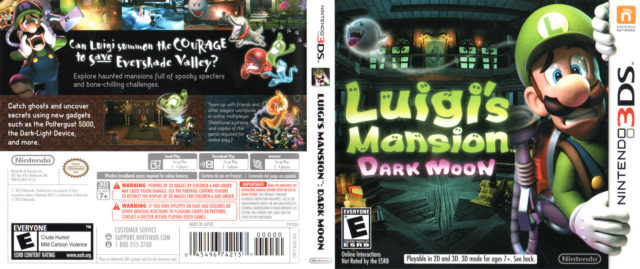
Dark Moon goes in a different direction with its pacing. By relying on stages to break up the storyline instead of the more spacious chapter breaks, Dark Moon pushes things along at a more brisk clip. Given Dark Moon‘s nature as a portable title, it’s understandable why Next Level Games thought it necessary to switch up the game structure like this. Mobile titles are meant for bursts of play versus extended sessions. Still, with a system like 3DS, it’s easy enough to simply close the lid and let the handheld sleep, making the need to mete out the game in chunks rather dubious. Indeed, many of the stages here last quite a while anyway, further clouding the rationalization behind the change.
The reason the stage structuring is problematic is because it wreaks havoc with the pacing. Luigi’s Mansion isn’t about how quickly it can be beaten, yet here we are in Dark Moon with a game that’s actively keeping track of how fast the player completes each stage. What’s worse is that the stages frequently send Luigi to retread the same terrain over and over. These retreads of course have different objectives and even sometimes alterations to the environment, but it nonetheless gets old having to stop, go back to E. Gadd’s Bunker, then be beamed back to the mansion. Over and over. And over. Rinse and repeat. Replaying Dark Moon, I never realized before how monotonous it could be going through the stages in this manner.
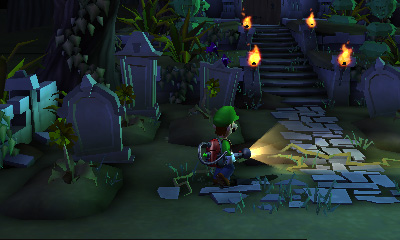
It’s especially vexing because Next Level Games did a wonderful job of creating mansions every bit as engaging as Luigi’s Mansion‘s noble estate. There’s a ton of details to soak in, from the car in the garage of Gloomy Manor, to the frozen interior of the Secret Mine. It’s frustrating not being able to freely wander about without being a slave to the crushing, cyclical nature of Dark Moon’s stage structure. Compounding the issue is another misstep by Next Level Games, which is the near-constant presence of E. Gadd. The professor went from being a guiding hand in Luigi’s Mansion to a hovering nuisance this time around.
The primary issue with E. Gadd in Dark Moon is that practically every action that Luigi takes is followed up by a call on the Dual Scream, a modded Nintendo DS that takes the place of the Game Boy Horror from the first game. While it’s initially fun hearing the jazzed up sound of the Luigi’s Mansion theme song as its ringtone, it quickly becomes maddening. Ghosts steal an item? E. Gadd calls. Discover a new location? E. Gadd calls. It’s incessant and irritating, taking hand-holding to a new low in a Nintendo game. Admittedly, there are times where E. Gadd shuts up and lets the player carry on, but it’s not enough to fully offset the times when he’s like an alarm clock without an “off” switch.
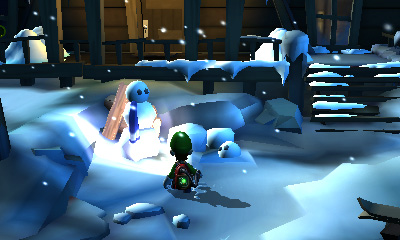
It’s a shame that E. Gadd and the pacing are so mishandled here, because they’re the only real blemishes on what is an otherwise very fun game. Dark Moon‘s biggest success lies in how many new, creative uses for the Poltergust Next Level Games was able to come up with. Now dubbed the Poltergust 5000, the vacuum can not only suck up ghosts, but also be used to inflate balloons to send Luigi skyward, as well as turn gears to interact with the environment. Between the updated Poltergust and the Dark Light Device, which can reveal hidden objects in the game world, Dark Moon has a much larger variety of mechanics to enjoy. If Luigi’s Mansion is guilty of anything, it’s a relative lack of things to do other than vacuuming ghosts.
What’s even more astounding about Dark Moon‘s success is that Next Level Games was able to build a sequel to Luigi’s Mansion without a second analogue stick! The C-Stick that was so integral to the original game’s control scheme is entirely absent in Dark Moon, as the baseline model of 3DS had only its Circle Pad and a D-Pad for directional input. Note that there actually was a chance to integrate a second control stick, as the Circle Pad Pro peripheral was coming out around the same time as the game, but the team at Next Level Games was so confident in its new control scheme that it deemed the addition didn’t bring anything worthwhile to the experience. I don’t know if I agree with that completely, but there’s no denying that they definitely did manage to do quite a bit with less. Dark Moon controls very smoothly.
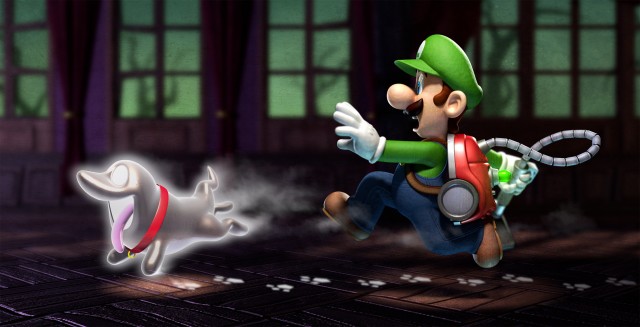
There’s multiplayer on offer here, which really doesn’t add to or detract from the experience. I personally find it to be one of the more superfluous elements of Dark Moon, along with the stage rankings. Neither multiplayer nor keeping track of level completion stats (outside of how much cash Luigi has accumulated!) speak to what the series is about. Luigi’s Mansion as a franchise is about the journey; it’s about exploration. It’s not about competition. It’s also about charm, and I have to hand it to Next Level Games, because Dark Moon has a ton of it, even with the various misfires. I recall that when this game came out, it prompted comparisons between Nintendo and animation house Pixar, a comparison that I wholeheartedly agree with. There are so many adorable character moments and interactions for Luigi in Dark Moon that truly highlight what a great character he is.
Overall, Dark Moon is a worthy successor to Luigi’s Mansion. It maintains much of the whimsy and joy of the original, but enhances the gameplay with additional mechanics and multiple mansions to explore. Where it fails is in its self-indulgences. Too much screen time for E. Gadd coupled with his need to practically walk the player from point A to B is grating. That’s not even mentioning other pacing problems spawned by the stage structure and needless stat-chasing. Despite these warts, though, I really feel like Next Level Games put a ton of heart into this sequel that shows through in the end. When Luigi’s Mansion returns on 3DS this month, it will be fun to see the direction developer Grezzo (the team handling the remake) takes with the game. Keep it tuned to Nintendojo as we inch closer to release!
And, if anyone is interested, seeing as we never assigned a grade to Dark Moon back in the day, I’d say it deserves a B-!




 ShareThis
ShareThis






I was gifted the original Luigi’s Mansion right around the time Dark Moon was announced, and after playing it for the first time I was stoked to be able to crack into the sequel. I had some of the same frustrations that Robert lists here, and quit before the final mansion.
I felt like the game was actively punishing me for exploring when I just wanted to find all the gems. After that I’m a little more “wait and see” on the next game for Switch, but I have a feeling the improved hardware is going to factor in as they plan what kind of game it will be.